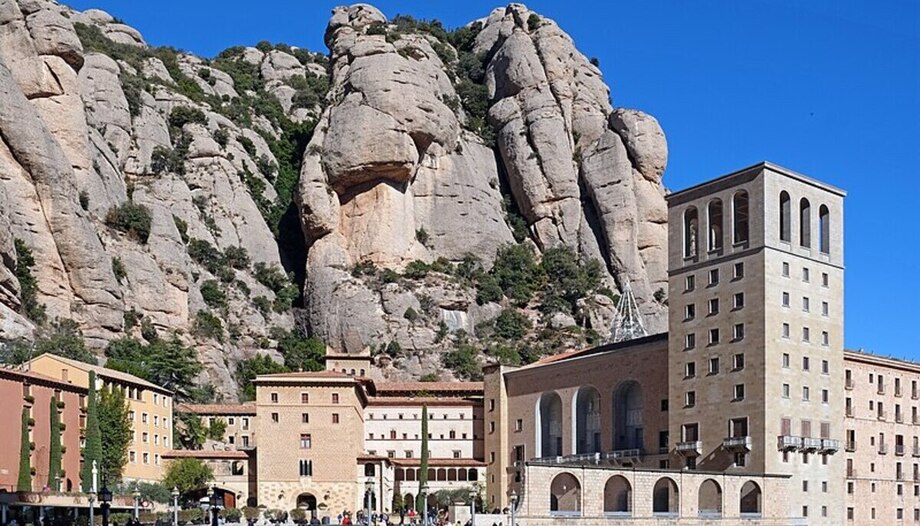The 19th century basilica, the Montserrat indoors audiovisual space or the museum of the sanctuary, with works by Caravaggio, El GrecoPicasso, Dalí or Monet are some of the essential places to visit in the sanctuary. There are also the monumental rosary and numerous hiking trails to enjoy the scenery.
Travel and approach
One of the attractions of Montserrat is the journey to the mountain itself, which can be done by train from Barcelona. The approach from Monistrol de Montserrat to the sanctuary can be made by connecting with a picturesque train that climbs 600 meters in about five kilometers. It is the famous rack railway. In Monistrol there is ample parking, if you prefer to get there by car.
At the stop before Monistrol, you can take the cable car, another way to reach the sanctuary. This "Montserrat aerial", as it is also known, makes the journey in five minutes and offers unique views of the mountain. Of course, you can also drive up to the parking lot of the sanctuary itself.
Basilica, atrium and museums
Once there, a visit to the Virgin is a must. You can access the dressing room, where she can be venerated. The basilica is the reconstruction of the nineteenth century of the remains of the Gothic of the late sixteenth century. It is very richly decorated, especially the area of the chapel of Santa Maria. The atrium of the basilica is dominated by the facade of the temple, neoplateresque of 1901 and surrounded by buildings. After the civil war, a new facade was built to close the courtyard. In it we find reliefs alluding to the proclamation of the dogma of the Assumption, St. Benedict and the representation of the monks martyred in that war.
An inscription on the façade contains a phrase attributed to Bishop Torres i Bages, which summarizes the spirit of Catholic Catalanism of which Montserrat has been the epicenter: "Catalunya serà cristiana o no serà" (Catalonia will be Christian or it will not be).
At the information office you can find directions to the audiovisual space entitled Montserrat indoors, which will introduce the pilgrim to the mountain, the monastery and the sanctuary.
Montserrat also has a museum that contains an important art collection with works by Caravaggio, El Greco, Rusiñol, Casas, Picasso, Dalí, Monet... and some archaeological remains from the Middle East.
Monumental rosary and trails
After the misfortunes of the 19th century, the Catalan cultural world committed itself to the restoration of Montserrat and, thanks to this, many literary and artistic works from the end of that century are dedicated to the Virgin.
We have already mentioned the creation of many poets and writers of those years. The world of the plastic arts also wanted to contribute. Thus, a monumental rosary was built between 1896 and 1916 on the road leading from the Sanctuary to the Holy Cave. Along the way, sculptural groups represent each of the fifteen mysteries. Notable artists such as Gaudí, Puig i Cadafalch, Sagnier, Llimona, the Vallmitjana brothers and others participated in this project. It is a pleasant walk to the place where the image was found that harmoniously combines nature and art.
Hiking is a good complement to the visit to Montserrat. The mountain is full of paths that connect hermitages and viewpoints. A traditional excursion is to climb to Sant Jeroni (1237 meters), the top of the mountain; it can also be combined with the ascent in the rack railway of Sant Joan and it is a circular route of just over two hours. It can also be climbed on foot to the sanctuary by trails from Monistrol. The Patronato de la Montaña offers some routes on its website.
The choir and the Virolai
There is evidence of the presence of a choir - a choir of children singers - since the early fourteenth century, which would make us think of one of the oldest in Europe. There were only a few choirboys until the XVII and XVIII centuries when it grew and became a real musical school. In the mid-twentieth century there were fifty singers and they began to record records and tour nationally and internationally.
Therefore, one of the essential moments of the visit to Montserrat is when the Escolania performs the Save and the Virolai.
The Virolai is the musicalization of the poem to Saint Mary of Montserrat that Jacint Verdaguer composed for the millennium (1880) of the discovery of the Virgin. A contest was held as part of the programmed events, to which more than sixty musical versions of the poem were submitted. The winner was Josep Rodoreda, who received the corresponding prize. Since then the Virolai, whose lyrics are beautiful, is part of the cultural heritage of any Catalan.








